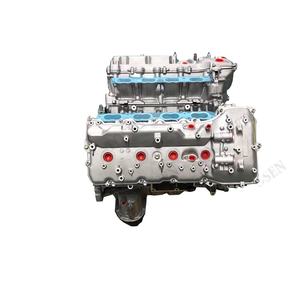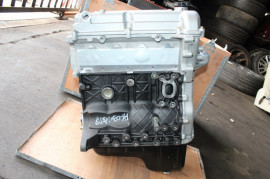Update Your Car with a New Opel Corsa Engine
Update Your Car with a New Opel Corsa Engine
Blog Article
Checking Out the Inner Operation of a Compact Vehicle's Engine System
As chauffeurs, we frequently take for provided the elaborate processes that happen within the boundaries of our automobile's engine system. In this exploration of a portable automobile's engine system, we will untangle the internal workings of this mechanical symphony, shedding light on the enigmas that drive us onward on our day-to-day journeys.
Combustion Process Overview
The combustion process in a portable vehicle's engine system is a crucial system that successfully converts gas into power to power the lorry. This process occurs within the combustion chamber of the engine, where fuel and air mix, stir up, and create regulated surges. The burning procedure contains four major phases: consumption, power, exhaust, and compression.
During the consumption phase, the piston relocates downward, reeling in a mix of air and gas into the combustion chamber. The following phase, compression, includes the piston relocating upward, pressing the air-fuel blend to increase its potency. Consequently, in the power stage, the spark plug sparks the compressed blend, resulting in a fast growth of gases that forces the piston pull back. This descending activity creates the power required to drive the lorry. In the exhaust stage, the burned gases are gotten rid of from the burning chamber through the exhaust shutoff, preparing the chamber for the next cycle. This cyclic burning procedure is essential to the procedure of a small lorry's engine system, making sure efficient power conversion for propulsion.
Piston and Cylinder Communication

The piston's accurate fit within the cyndrical tube is essential for keeping ideal compression and preventing power loss during combustion. Limited clearances between the piston and cylinder wall surfaces ensure efficient sealing, enabling the piston to move smoothly without permitting gases to leakage past. Correct lubrication is additionally crucial to minimize rubbing and put on in between these components, enhancing longevity and performance.
Moreover, the design and materials utilized in producing the piston and cylinder influence engine performance and resilience. Modern engines usually employ light-weight yet straight from the source resilient products like aluminum alloys for pistons and cyndrical tube linings to decrease inertia and boost thermal performance. In general, the harmonious communication in between the piston and cyndrical tube is fundamental to the engine's capability and overall performance.
Fuel Injection System Performance
Gas shot systems in compact automobile engines play a vital role in precisely delivering fuel to the combustion chamber for effective and controlled ignition. The gas injection system functions by injecting gas right into the combustion chamber at the optimal moment throughout the engine's operation (opel corsa engine). This accurate timing guarantees that the fuel blends equally with the air for appropriate burning, bring about boosted fuel effectiveness and minimized exhausts
There are primarily 2 sorts of fuel injection systems made use of in compact lorry engines: port gas shot (PFI) and direct gas shot (DFI) PFI systems inject fuel into the consumption port prior to the consumption valve, while DFI systems inject fuel directly right into the combustion chamber. Both systems have their advantages, with DFI providing far better fuel atomization and PFI supplying a more cost-effective solution.
Recognizing Engine Cooling Mechanisms
Effective procedure of a compact lorry's engine relies greatly on the effectiveness of its cooling systems. The cooling system in a small vehicle typically is composed of numerous elements functioning together to manage the engine temperature level. Understanding these engine cooling devices is vital for maintaining the performance and longevity of a portable car's engine system.

Exhaust System Components Explained
The ideal functioning of a portable car's engine air conditioning systems depends on a complementary system known as the exhaust system, which makes up numerous crucial components for ensuring effective discharges and engine efficiency. The exhaust manifold accumulates exhaust gases from the engine's courses and cylinders them to the catalytic converter.
One crucial component of the exhaust system is the oxygen sensing unit, which keeps track of the oxygen levels in the exhaust gases to assist control gas usage and make sure optimal engine efficiency. opel corsa engine. Furthermore, the resonator might exist in some exhaust systems to minimize noise levels. In general, the other exhaust system plays an essential function in preserving engine performance, minimizing hazardous exhausts, and ensuring a quieter driving experience for small lorry owners

Conclusion
In conclusion, the small vehicle's engine system is an intricate combination of components that work with each other to assist in the burning process, transform gas right into energy, and expel waste gases. Understanding the inner operations of the engine system, consisting of the more piston and cyndrical tube interaction, fuel injection system, engine air conditioning devices, and exhaust system components, is vital for keeping optimal efficiency and performance of the car.
The combustion process in a portable lorry's engine system is a vital system that effectively transforms gas right into power to power the car.Fuel shot systems in small vehicle engines play a vital function in precisely delivering fuel to the combustion chamber for regulated and efficient ignition.There are mainly 2 kinds of gas injection systems used in small automobile engines: port gas shot (PFI) and straight gas injection (DFI) Recognizing these engine cooling devices is vital for preserving the efficiency and longevity of a portable lorry's engine system.
The optimum functioning of a compact automobile's engine cooling mechanisms depends on a corresponding system recognized as the exhaust system, which comprises numerous necessary parts for making sure effective emissions and engine efficiency.
Report this page